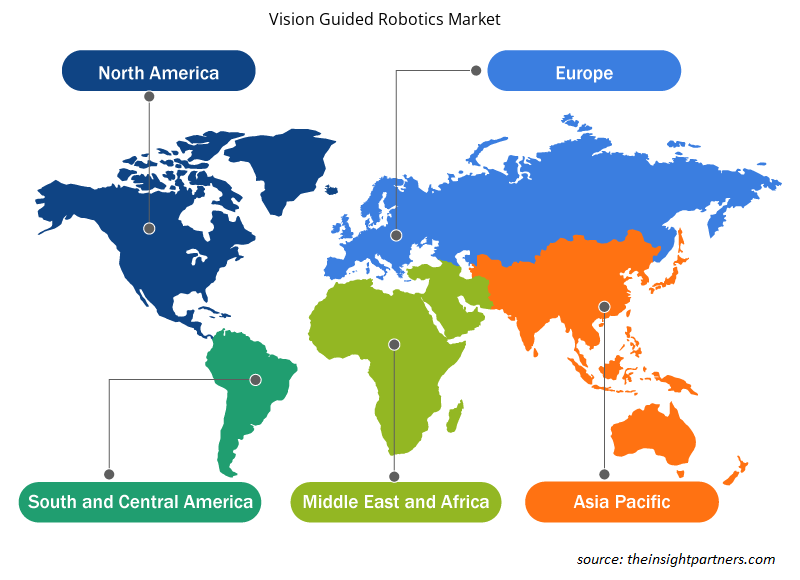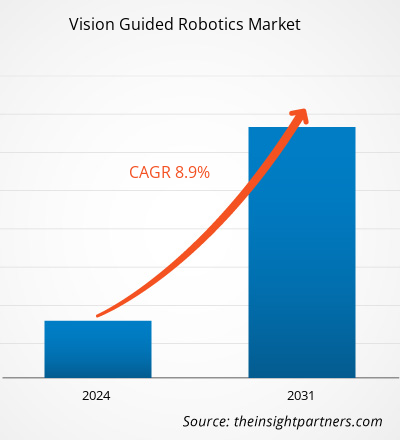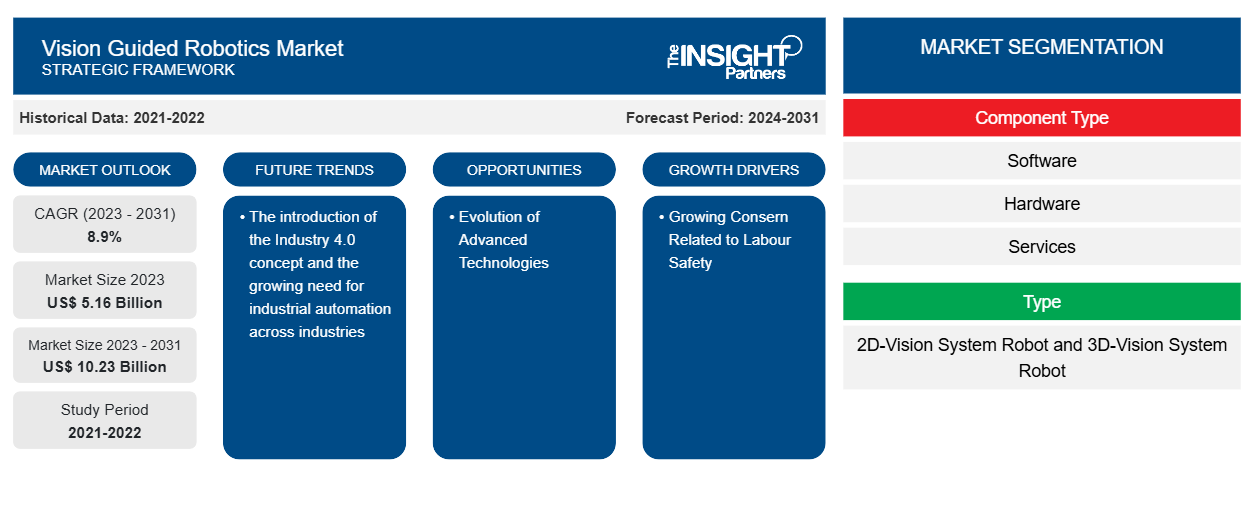من المتوقع أن يصل حجم سوق الروبوتات الموجهة بالرؤية إلى 10.23 مليار دولار أمريكي بحلول عام 2031 من 5.16 مليار دولار أمريكي في عام 2023. ومن المتوقع أن يسجل السوق معدل نمو سنوي مركب بنسبة 8.9٪ في الفترة 2023-2031. ومن المرجح أن يظل تقديم مفهوم الصناعة 4.0 والحاجة المتزايدة إلى الأتمتة الصناعية عبر الصناعات اتجاهًا رئيسيًا في سوق الروبوتات الموجهة بالرؤية.
تحليل سوق الروبوتات الموجهة بالرؤية
ينمو سوق الروبوتات الموجهة بالرؤية بوتيرة سريعة بسبب الاهتمام المتزايد بسلامة العمل، والطلب المتزايد على فحص الجودة والتحكم بين الصناعات، والاعتماد المتزايد على الروبوتات الموجهة بالرؤية في الشركات الصغيرة والمتوسطة الحجم. يتوسع السوق بشكل مطرد، مدفوعًا بالاستخدام المتزايد للروبوتات التعاونية في إعدادات التصنيع التعاوني. علاوة على ذلك، فإن تطور التقنيات المتقدمة والتطورات في تكنولوجيا الرؤية الآلية توفر فرصًا مربحة لنمو السوق.
نظرة عامة على سوق الروبوتات الموجهة بالرؤية
الروبوتات الموجهة بالرؤية هي نظام روبوتي يستخدم خوارزميات الرؤية الحاسوبية والكاميرات للسماح للروبوتات بإنجاز المهام التي تتطلب الإدراك البصري والتفسير. الفكرة الأساسية وراء الروبوتات الموجهة بالرؤية هي إعطاء الروبوتات القدرة على رؤية وفهم محيطها، مما يسمح لها بالتنقل والتفاعل مع الأشياء وأداء المهام بدقة وكفاءة أكبر. غالبًا ما تستخدم الروبوتات الموجهة بالرؤية كاميرات عالية الدقة ومعالجة الصور الحديثة وخوارزميات التعلم الآلي لتقييم البيانات المرئية وإصدار الأحكام بناءً عليها. تُستخدم الروبوتات الموجهة بالرؤية بشكل شائع في أنشطة الالتقاط والوضع والتجميع والتفتيش والتعبئة ومراقبة الجودة. إن التبني المتزايد للروبوتات الموجهة بالرؤية في العديد من الصناعات، مثل صناعة السيارات والفضاء والدفاع والأغذية والمشروبات والكهرباء والإلكترونيات والرعاية الصحية والأدوية ومعالجة المعادن وغيرها، هو المحرك للسوق.
قم بتخصيص هذا التقرير ليناسب متطلباتك
ستحصل على تخصيص لأي تقرير - مجانًا - بما في ذلك أجزاء من هذا التقرير، أو تحليل على مستوى الدولة، وحزمة بيانات Excel، بالإضافة إلى الاستفادة من العروض والخصومات الرائعة للشركات الناشئة والجامعات
-
احصل على أهم اتجاهات السوق الرئيسية لهذا التقرير.ستتضمن هذه العينة المجانية تحليلاً للبيانات، بدءًا من اتجاهات السوق وحتى التقديرات والتوقعات.
محركات وفرص سوق الروبوتات الموجهة بالرؤية
القلق المتزايد بشأن سلامة العمالة هو المحرك للسوق
مع تزايد صرامة متطلبات السلامة العمالية الدولية، تتحول الصناعات في جميع أنحاء العالم إلى تفضيلها نحو تبني الروبوتات من خلال استبدال العمال البشر في المناطق الخطرة. يمكن للروبوتات أداء مهام ضارة وغير آمنة للبشر، مما يزيد من الطلب عليها في المناطق الخطرة، بما في ذلك العمل في التضاريس القاسية وإدارة المواد الخطرة. يمكن للصناعات تقليل المخاطر، وعدد حوادث مكان العمل باستخدام الروبوتات في بيئات خطرة معينة يغذي سوق الروبوتات الموجهة بالرؤية خلال فترة التنبؤ.
تطور التقنيات المتقدمة – فرصة في سوق الروبوتات الموجهة بالرؤية
أدى إدخال التكنولوجيا الجديدة إلى تطوير روبوتات أكثر فعالية وكفاءة في السوق. يمكن لهذه الروبوتات المتقدمة تقنيًا القيام بالمهام بدقة وإتقان أعلى، مما يؤدي إلى انخفاض التكاليف. وبالتالي، خلق فرص في نمو السوق خلال فترة التنبؤ.
لقد أدى التقدم التكنولوجي إلى جعل أنظمة الروبوتات أكثر إحكاما وقابلية للتكيف، مما أدى إلى إنتاج روبوتات ذات جودة أعلى وأكثر تنوعًا. إن الاستخدام المتزايد للروبوتات المعززة والقابلة للتكيف يولد فرص نمو كبيرة للسوق في المستقبل القريب.
تقرير تحليل تجزئة سوق الروبوتات الموجهة بالرؤية
إن القطاعات الرئيسية التي ساهمت في اشتقاق تحليل سوق الروبوتات الموجهة بالرؤية هي نوع المكون والنوع والقطاع الرأسي للصناعة.
- بناءً على نوع المكون، ينقسم سوق الروبوتات الموجهة بالرؤية إلى برمجيات وأجهزة وخدمات. احتل قطاع الأجهزة حصة سوقية أكبر في عام 2023.
- على أساس النوع، يتم تقسيم السوق إلى روبوتات نظام الرؤية ثنائية الأبعاد وروبوتات نظام الرؤية ثلاثية الأبعاد. احتلت شريحة روبوتات نظام الرؤية ثلاثية الأبعاد حصة سوقية أكبر في عام 2023.
- من حيث القطاعات الصناعية، يتم تصنيف السوق على أنها السيارات، والفضاء والدفاع، والأغذية والمشروبات، والرعاية الصحية والأدوية، والكهرباء والإلكترونيات، ومعالجة المعادن، وغيرها. احتل قطاع السيارات حصة سوقية أكبر في عام 2023.
تحليل حصة سوق الروبوتات الموجهة بالرؤية حسب المنطقة الجغرافية
ينقسم النطاق الجغرافي لتقرير سوق الروبوتات الموجهة بالرؤية بشكل أساسي إلى خمس مناطق: أمريكا الشمالية، ومنطقة آسيا والمحيط الهادئ، وأوروبا، والشرق الأوسط وأفريقيا، وأمريكا الجنوبية/أمريكا الجنوبية والوسطى.
من حيث الإيرادات، استحوذت منطقة آسيا والمحيط الهادئ على أكبر حصة في سوق الروبوتات الموجهة بالرؤية، وذلك بفضل التقنيات الناشئة والحجم الكبير من قدرات التصنيع. وعلاوة على ذلك، من المتوقع أن يؤدي النشر المتزايد لمفهوم الصناعة 4.0 والاستثمار المتزايد من الشركات لإنشاء مرافق التصنيع إلى تغذية الطلب طوال فترة التوقعات.
أخبار سوق الروبوتات الموجهة بالرؤية والتطورات الأخيرة
يتم تقييم سوق الروبوتات الموجهة بالرؤية من خلال جمع البيانات النوعية والكمية بعد البحث الأولي والثانوي، والذي يتضمن منشورات الشركات المهمة وبيانات الجمعيات وقواعد البيانات. فيما يلي قائمة بالتطورات في سوق الروبوتات الموجهة بالرؤية والاستراتيجيات:
- في مارس 2023، شاركت شركة Smart Vision Lights في رعاية ندوة عبر الإنترنت لمجلة Quality Magazine والتي تتناول التطور الأخير في الروبوتات الموجهة بالرؤية وتساعد في توجيه الشركات التي تبحث عن حلول أتمتة جديدة. ستخدم الندوة عبر الإنترنت كل المهتمين بتكنولوجيا الروبوتات الموجهة بالرؤية بما في ذلك إدارة الشركة والجودة والمصانع والهندسة والعمليات بغض النظر عن السوق. (المصدر: Smart Vision Lights، بيان صحفي، 2023)
تقرير سوق الروبوتات الموجهة بالرؤية والتغطية والنتائج النهائية
يوفر تقرير "حجم سوق الروبوتات الموجهة بالرؤية والتوقعات (2023-2031)" تحليلاً مفصلاً للسوق يغطي المجالات التالية:
- حجم السوق والتوقعات على المستويات العالمية والإقليمية والوطنية لجميع قطاعات السوق الرئيسية التي يغطيها النطاق
- ديناميكيات السوق مثل المحركات والقيود والفرص الرئيسية
- الاتجاهات المستقبلية الرئيسية
- تحليل مفصل لقوى PEST/Porter الخمس وSWOT
- تحليل السوق العالمي والإقليمي الذي يغطي اتجاهات السوق الرئيسية واللاعبين الرئيسيين واللوائح والتطورات الأخيرة في السوق
- تحليل المشهد الصناعي والمنافسة الذي يغطي تركيز السوق، وتحليل خريطة الحرارة، واللاعبين البارزين، والتطورات الأخيرة
- ملفات تعريف الشركة التفصيلية
نطاق التقرير
رؤى إقليمية حول سوق الروبوتات الموجهة بالرؤية
لقد قام المحللون في Insight Partners بشرح الاتجاهات والعوامل الإقليمية المؤثرة على سوق الروبوتات الموجهة بالرؤية طوال فترة التوقعات بشكل شامل. يناقش هذا القسم أيضًا قطاعات سوق الروبوتات الموجهة بالرؤية والجغرافيا في جميع أنحاء أمريكا الشمالية وأوروبا ومنطقة آسيا والمحيط الهادئ والشرق الأوسط وأفريقيا وأمريكا الجنوبية والوسطى.

- احصل على البيانات الإقليمية المحددة لسوق الروبوتات الموجهة بالرؤية
نطاق تقرير سوق الروبوتات الموجهة بالرؤية
| سمة التقرير | تفاصيل |
|---|---|
| حجم السوق في عام 2023 | 5.16 مليار دولار أمريكي |
| حجم السوق بحلول عام 2031 | 10.23 مليار دولار أمريكي |
| معدل النمو السنوي المركب العالمي (2023 - 2031) | 8.9% |
| البيانات التاريخية | 2021-2022 |
| فترة التنبؤ | 2024-2031 |
| القطاعات المغطاة |
حسب نوع المكون
|
| المناطق والدول المغطاة |
أمريكا الشمالية
|
| قادة السوق وملفات تعريف الشركات الرئيسية |
|
كثافة اللاعبين في سوق الروبوتات الموجهة بالرؤية: فهم تأثيرها على ديناميكيات الأعمال
يشهد سوق الروبوتات الموجهة بالرؤية نموًا سريعًا، مدفوعًا بالطلب المتزايد من المستخدم النهائي بسبب عوامل مثل تفضيلات المستهلكين المتطورة والتقدم التكنولوجي والوعي الأكبر بفوائد المنتج. ومع ارتفاع الطلب، تعمل الشركات على توسيع عروضها والابتكار لتلبية احتياجات المستهلكين والاستفادة من الاتجاهات الناشئة، مما يؤدي إلى زيادة نمو السوق.
تشير كثافة اللاعبين في السوق إلى توزيع الشركات أو المؤسسات العاملة في سوق أو صناعة معينة. وهي تشير إلى عدد المنافسين (اللاعبين في السوق) الموجودين في مساحة سوق معينة نسبة إلى حجمها أو قيمتها السوقية الإجمالية.
الشركات الرئيسية العاملة في سوق الروبوتات الموجهة بالرؤية هي:
- شركة أي بي بي المحدودة
- شركة باسلر
- كوجنكس
- شركة دينسو
- شركة فانوك
- رؤية الجمعية
إخلاء المسؤولية : الشركات المذكورة أعلاه ليست مرتبة بأي ترتيب معين.

- احصل على نظرة عامة على أهم اللاعبين الرئيسيين في سوق الروبوتات الموجهة بالرؤية
- التحليل التاريخي (سنتان)، سنة الأساس، التوقعات (7 سنوات) مع معدل النمو السنوي المركب
- تحليل PEST و SWOT
- حجم السوق والقيمة / الحجم - عالمي، إقليمي، بلد
- الصناعة والمنافسة
- مجموعة بيانات إكسل
التقارير الحديثة
شهادات العملاء
سبب الشراء
- اتخاذ قرارات مدروسة
- فهم ديناميكيات السوق
- تحليل المنافسة
- رؤى العملاء
- توقعات السوق
- تخفيف المخاطر
- التخطيط الاستراتيجي
- مبررات الاستثمار
- تحديد الأسواق الناشئة
- تحسين استراتيجيات التسويق
- تعزيز الكفاءة التشغيلية
- مواكبة التوجهات التنظيمية























 احصل على عينة مجانية ل - سوق الروبوتات الموجهة بالرؤية
احصل على عينة مجانية ل - سوق الروبوتات الموجهة بالرؤية